Categories
Archives
The 2024 IPTC Photo Metadata Conference takes place as a webinar on Tuesday 7th May from 1500 – 1800 UTC. Speakers hail from Adobe (makers of Photoshop), CameraBits (makers of PhotoMechanic), Numbers Protocol, Colorhythm, vAIsual and more.
First off, IPTC Photo Metadata Working Group co-leads, David Riecks and Michael Steidl, will give an overview of what has been happening in the world of photo metadata since our last Conference in November 2022, including IPTC’s work on metadata for AI labelling, “do not train” signals, provenance, diversity and accessibility.
Next, a panel session on AI and Image Authenticity: Bringing trust back to photography? discusses approaches to the problem of verifying trust and credibility for online images. The panel features C2PA lead architect Leonard Rosenthol (Adobe), Dennis Walker (Camera Bits), Neal Krawetz (FotoForensics) and Bofu Chen (Numbers Protocol).
Next, James Lockman of Adobe presents the Custom Metadata Panel, which is a plugin for Photoshop, Premiere Pro and Bridge that allows for any XMP-based metadata schema to be used – including IPTC Photo Metadata and IPTC Video Metadata Hub. James will give a demo and talk about future ideas for the tool.
Finally, a panel on AI-Powered Asset Management: Where does metadata fit in? discusses teh relevance of metadata in digital asset management systems in an age of AI. Speakers include Nancy Wolff (Cowan, DeBaets, Abrahams & Sheppard, LLP), Serguei Fomine (IQPlug), Jeff Nova (Colorhythm) and Mark Milstein (vAIsual).
The full agenda and links to register for the event are available at https://iptc.org/events/photo-metadata-conference-2024/
Registration is free and open to anyone who is interested.
See you there on Tuesday 7th May!

Last week the IPTC held another very successful member meeting. The 2023 IPTC Autumn Meeting, held virtually this time, had well over 50 attendees from over 30 organisations in at least 15 different countries.
Highlights included Standards Committee approval of a brand new standard, IPTC Sport Schema v1.0, plus the approval of three new versions of existing standards: NewsML-G2 v2.33, IPTC Photo Metadata Standard 2023.1, and Video Metadata Hub v1.5. We will be publishing more information about each of these updates over the coming weeks.
We also heard from two real-world projects in the broadcast industry. One has just completed and the other is still in its planning stages, but both are based on IPTC standards. The ASBU Cloud system was presented by IPTC member Broadcast Solutions, and the DPP Live Production Exchange was presented by new IPTC member Arqiva.
We also heard guest presentation from Will Kreth of the HAND talent identity platform, the latest on C2PA and Project Origin, had a demo of IPTC Sport Schema using MarkLogic from Progress Software (also an IPTC member).
All Working Groups presented their recent work, which included interesting discussions about proposed new NewsCodes vocabularies and how to address the needs of Artificial Intelligence across all of our standards, work that has been going on for years but now acquires a new urgency.
At the IPTC Annual General Meeting 2023, we voted in the existing Board of Directors for another term and and heard updates about all the great work that has taken place at IPTC this year.
It was a great event and we are already looking forward to the next member meeting, to be held in person in New York in April 2024!
The IPTC is pleased to announce the final agenda for next week’s IPTC Autumn Meeting.
Held online via Zoom from 13.00 to 18.00 UTC from Monday to Wednesday, the meeting will include:
Monday 2 October
- Working Group presentations:
- Video Metadata Working Group who will be proposing a new version of Video Metadata Hub handling metadata specifying whether content can be included in AI training data and other forms of data mining
- Sports Content Working Group who will be proposing the 1.0 version of the new IPTC Sport Schema standard
- Member presentations:
- Demo of how to implement IPTC Sport Schema in MarkLogic and Semaphore from Progress Software
- Guest presentations:
- Update from the HAND project: a new approach to identity in media and entertainment
Tuesday 3 October
- Working Group presentations:
- NewsML-G2 Working Group who will be proposing a new version of NewsML-G2 that includes Digital Source Type metadata to bring it in line with other IPTC standards
- Photo Metadata Working Group who will be proposing a new version of the IPTC Photo Metadata Standard handling metadata specifying whether content can be included in AI training data and other forms of data mining
- NewsCodes Working Group (including a discussion of a proposed new vocabulary on “editorial tone”)
- Member presentations:
- Broadcast Solutions presenting the ASBU Cloud project, based on NewsML-G2
- New member Newsbridge presenting how their systems implement IPTC standards
- Guest presentations:
- Update on Project Origin and C2PA, featuring the CEO of Media City Bergen, Helge Svela
Wednesday 4 October
- IPTC Annual General Meeting 2023
- Election of IPTC Board of Directors and Chair
- Approval of budget for 2023
- Updates from the Managing Director and Chair of the Board of Directors
- IPTC Autumn 2023 Standards Committee meeting
- Votes on new versions of NewsML-G2, Photo Metadata Standard, Video Metadata Hub and presenting proposed new standard IPTC Sport Schema
- Working Group presentations:
- News in JSON Working Group
- Working Group and member presentations:
- Discussion on a simple rights format
- DPP Live Production Exchange (LPX) project from CNN and new member Arqiva
IPTC member representatives can view the full schedule on the IPTC Autumn Meeting 2023 event page in the Members-Only Zone.
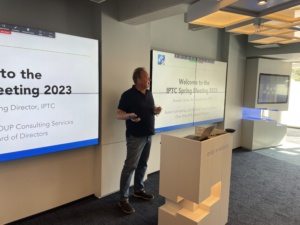
We have just finished the IPTC Spring Meeting in Tallinn, Estonia. Our first face-to-face IPTC Member Meeting since 2019, those who could attend in person were very happy to be back together, enabling collaboration, knowledge sharing and building bonds across organisations in the media industry.
We were also joined by over 50 online attendees from IPTC member organisations, who braved sometimes difficult timezone differences to view many of the sessions in real time and participate in discussions. Other IPTC members who weren’t able to be there either physically or virtually will be able to watch recordings of the sessions soon.
Themes this time obviously included Generative AI, but also fact-checking and provenance, social media embedding and social stories,
Highlights of the Monday included a special briefing about digital citizenship and digital governance at the e-Estonia Briefing Centre, where members heard from an Estonian government representative who described Estonia’s electronic tax, medicine, administration and even e-voting system, all powered by the cryptographically-protected digital ID card and the X-Road system of interconnecting all of e-Estonia’s services, across both the private and public sector.
Also on the Monday we heard from Gerd Kamp (dpa) who explained how dpa are using Web Components technology to embed social media into their articles in a way that’s much easier for their customers to process. We also heard Working Group presentations and new standard proposals from the NewsML-G2 Working Group and the News in JSON Working Group, whose lead Johan Lindgren (TT) handed over the reins to Ian Young (PA Media / Alamy) who promises to be a fine leader of the group in the future. We say many thanks to Johan for all his contributions to IPTC over the past 25 years!
We also heard from Evi Varsou (ATC) who demonstrated some of ATC’s tools for fighting fake news and misinformation, used by some of the world’s top news organisations.
Day 2 saw Dave Compton (Refinitiv, an LSE Group Company) describe some of their work on handling augmenting news content in real time with analytics information. Then we heard invited speaker Maria Amelie (Factiverse) talk about her troubles with the Norwegian authorities, being deported, and eventually getting Norwegian law changed to support refugees like herself. She now runs the startup Factiverse which is looking at using AI to help promote fact checks as fast as possible, via their site Factisearch (among other projects).
After a discussion on rights and RightsML, we heard from Estonian startup Texta (who provide several tools for media organisations, including an automated comment feed moderator that works in many languages), and German startup Storifyme.com who have created a tool that lets media companies quickly and easily create social posts from news stories – still very relevant even as Google AMP is being wound down.
Tuesday was rounded off by Jennifer Parrucci (The New York Times) presenting the NewsCodes Working Group‘s update, and Paul Kelly (Individual Member) giving an update on the huge amount of work on IPTC Sport Schema from the Sports Content Working Group.
On Wednesday, after an EGM voting on an update to the Articles of Association, we heard from Charlie Halford (BBC) on Project Origin and C2PA, and Sebastian Posth of International Standard Content Code.
We also voted in updates to NewsML-G2 and ninjs, which will be announced here soon.
We’re already looking forward to the Autuymn Meeting, held in October online, and Spring Meeting 2024, hopefully in New York City!
We had a great Photo Metadata Conference last Thursday. Thanks to those who attended. For those who didn’t, or those who would like to go over some detail again, here we publish full recordings of all sessions.
First up, Brendan Quinn, IPTC Managing Director introduced the day and gave an overview of what was to come:
Next was a great panel on adoption of the accessibility properties added in the 2021.1 update to the IPTC Photo Metadata Standard. We are very happy to share that the fields are now supported in many popular photo creating and editing tools, with more to come:
Next was David Riecks and Michael Steidl, co-leads of the IPTC Photo Metadata Working Group, presenting the work done by the Working Group since the last Photo Metadata Conference:
Then came a session on real-world implementations of the C2PA specification for content authenticity, including presentations from Microsoft, CBC / Radio Canada, the BBC and Adobe / Content Authenticity Initiative:
The last session was a panel discussion on Metadata for AI Images, looking at questions around the ethics of using copyrighted content to train a machine learning engine to generate AI images, and how the IPTC Photo Metadata Standard could be extended to support metadata appropriate for AI-generated images:
We had a great session and a packed conference! We look forward to seeing everyone again at next year’s event.
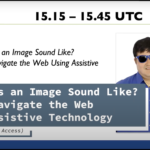
The IPTC Photo Metadata Working Group is proud to announce the IPTC Photo Metadata Conference 2022. The event will be held online on Thursday November 10th from 15.00 – 18.00 UTC.
This year the theme is Photo Metadata in the Real World. After introducing two new developments last year: the IPTC Accessibility properties and the C2PA specification for embedding provenance data in photo and video content – we re-visit both technologies to see how they are being adopted by software systems, publishers and broadcasters around the world.
The 3-hour meeting will host four sessions:
- Adoption of the IPTC Accessibility Properties – we hear from vendors and content creators on how they are progressing in implementing the new properties to support accessibility
- Software Supporting the IPTC Photo Metadata Standard – showcasing an update to IPTC’s directory of software supporting the IPTC Photo Metadata Standard, including field-by-field reference tables letting users compare software implementations
- Use of C2PA in real workflows – showcasing early work on implementing the C2PA specification in media organisations
- Artificial Intelligence and metadata – looking at the questions around copyright and synthetic media: for example, when generative AI uses thousands of potentially copyrighted images to train machine learning models, who owns the resulting images?
We look forward to welcoming all interested parties to the conference – no IPTC membership is needed to attend. The event will be held as a Zoom webinar.
Please see more information and the Zoom registration link on the event page.
See you there on the November 10th!
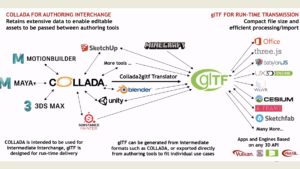
Last week the IPTC held its Autumn Meeting 2022, with over 70 attendees from over 20 countries attending the three-day online event.
Discussions were as wide-ranging as ever. Highlights were a guest presentation on how media organisations can prepare for the Metaverse from startup advisor and previous member of the Microsoft HoloLens team, Toby Allen; intense discussions from members about making our work in machine-readable rights and RightsML simpler and more accessible and to bridge the gap between our simple, lightweight JSON news standard ninjs and our richly structured full-featured XML-based standard NewsML-G2.
We also heard about many other topics:
- Meinolf Ellers at IPTC member dpa spoke about the DRIVE initiative, which follows on from the C-POP project that IPTC advised on in 2019 and 2020. DRIVE allows consortium members to share data about content usage to drive subscriptions and engagement, and to find under-represented areas in their news output to meet audience needs.
- We heard about representing social media content in NewsML-G2: Dave Compton of Refinitiv spoke about their work encoding content from Twitter and other social networks in NewsML-G2 format for re-use, enhancement and syndication.
- Will Kreth, previously CEO of EIDR, spoke about the HAND project which aims to create a unique identifier for media and sports talent
- Fredrik Lundberg from IPTC member iMatrics and guest presenter Jens Pehrson from GOTA Media spoke about a new tool they have developed that allows publishers to track the gender balance in their news content
- Johan Lindgren from IPTC member TT (the Swedish national news agency) spoke about their recent project to develop a classification and entity extraction engine for their news content, based on IPTC Media Topics taxonomy
- We heard from Audren Layeux of CARSA who spoke about the European Media Data Space project, an EU initiative
- Ben Colman, CEO of RealityDefender spoke (direct from TechCrunch Disrupt in San Francisco!) about their deepfake detection technology, used by social media networks, financial institutions and media organisations to detect manipulated images and videos.
- IPTC MD Brendan Quinn spoke about IPTC’s ongoing work with C2PA and Project Origin, including forthcoming additions to C2PA to include video metadata.
In addition, we heard updates from all IPTC Working Groups: Dave Compton introduced NewsML-G2 2.31; Paul Kelly spoke about some new developments in the RDF-based sports data model which will be announced soon; Pam Fisher described the work of the Video Metadata Working Group and the changes coming in Video Metadata Hub v1.4; David Riecks and Michael Steidl spoke about Photo Metadata Standard 2022.1 and the ongoing work of the Photo Metadata Working Group;
The Standards Committee voted in new standard versions: NewsML-G2 v2.31, Video Metadata Hub v1.4, and Photo Metadata Standard 2022.1. These will be released and publicised over the coming weeks.
The IPTC Annual General Meeting 2022 saw Johan Lindgren step down from the Board of Directors after 6 years of service. Thanks very much for all your help, Johan!
We are very happy to welcome a new Board member: Heather Edwards of Associated Press.
Thanks very much to everyone who attended and spoke. You contributed to making it a great event for all!
As usual, full recordings of all sessions are available to IPTC members on the members-only event page.
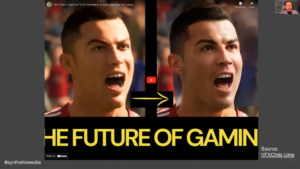
Where else can you hear about the difficulties of examining photo metadata in NFTs, see a lifelike image of a human being generated from pure data before your eyes, see how Wikidata can be used to take semantic fingerprints of news articles, and discover that an hour is nowhere near long enough to discuss simplifying machine-readable rights? Nowhere but the IPTC Meeting, of course! And this year’s Spring Meeting was the venue for all of this and much more.
We held the meeting virtually from Monday May 16 to Wednesday May 18th, and attending were over 70 people from at least 45 organisations across more than 20 countries.
Along with our usual Working Group updates and committee meetings, we invited speakers from several fascinating startups, services and projects at member companies. Here’s a quick summary of their sessions:
- We heard from Kairntech who are working on a classification system based on extracting entities from news stories and building a “semantic fingerprint” which can be used for cross-language classification, search and content enhancement
- The New York Times’ R&D Lab presented PaperTrail, a project to enhance the quality of the Times’ print archive through the use of machine learning to improve on basic OCR techniques (they’re looking for collaborators, more info coming soon!)
- Bria.ai showed us how an API can be used to enhance and create images and videos through the use of a custom GAN model trained in a “responsible AI” method
- Margaret Warren talked us through her efforts in creating and selling an NFT, looking at the process view the perspective of a photo metadata expert
- Consultant and author Henrik de Gyor talked us through the latest in synthetic media, which will be helpful in helping us to finalise our Digital Source Type vocabulary for synthetic media
- Laurent Le Meur from EDRLab presented his project’s recommendation on a Text and Data Mining Reservation Protocol, which can be used by publishers to restrict the rights of data miners in scraping any content for the purpose of analysis or building a model
- We heard from Dominic Young of Axate on his approach to offer pay-as-you-go payment options on paywalled news sites based on a simple pre-paid wallet mechanism.
We also had many announcements and discussions around IPTC standards, many of which we will be revealing in the coming months. One notable update is that the Standards Committee approved ninjs version 1.4 which we will release soon.
Thanks to all the IPTC members, Working Group leads, committee members and guests who made this member meeting one to remember.
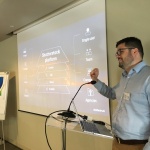
With less than two weeks to go, we are pleased to announce the full agenda for the IPTC Spring Meeting 2022.
The IPTC Spring Meeting 2022 will be held virtually from Monday May 16th to Wednesday May 18th, from 1300 – 1800 UTC each day.
IPTC member representatives can view the full agenda and register at https://iptc.org/moz/events/spring-meeting-2022/
Highlights of the meeting include:
- Updates from all IPTC Working Groups, including Photo Metadata, Video Metadata, NewsCodes, Sports Content, NewsML-G2 and News in JSON
- Updates from the IPTC PR Committee and the IPTC Standards Committee, including votes on proposed new versions of IPTC standards
- Invited presentations from:
- United Robots, presenting their “robot journalism” system built for media companies
- Axate‘s micropayments system for publishers
- Kairntech presenting their content classification system used by Agence France-Presse among others
- Bria.ai‘s image generation and manipulation API backed with cutting-edge artificial intelligence
- Consultant Henrik de Gyor speaking on the latest developments in synthetic media
- Laurent Le Meur from EDRLab discussing the W3C Text and Data Mining Community Group’s recommendation for a Text and Data Mining Reservation Protocol
- Member presentations:
- Recently-joined IPTC members will have a chance to introduce themselves and their organisations to the IPTC membership
- The New York Times presenting their “Papertrail” system used to target advertising based on content metadata
- Margaret Warren from ImageSnippets discussing what she learned when creating NFTs from her artwork
- Member discussions:
- IPTC members will be discussing how we might be able to simplify rights management with a cut-down basic set of rights assertions, possibly creating a simpler alternative to RightsML
- IPTC members will also be discussing the News Architecture and how we can better utilise the key data model that underlies both NewsML-G2 and ninjs
- and more!
Attendance to the 2022 IPTC Spring Meeting is free for all delegates and member experts from IPTC member organisations.
Invited speakers are welcome to attend the day on which they are speaking.
We had a great IPTC Photo Metadata Conference last week, focussing on accessibility, interoperability and authenticity.
Videos of all sessions are embedded in this post. Videos are also available from the event page. All videos have subtitles available – just click the “CC” button in the YouTube toolbar at the bottom of each video.
We started off with an introduction from IPTC Managing Director, Brendan Quinn:
Accessibility and “Born Accessible Content”
We then went into the first session, where David Riecks, co-lead of the IPTC Photo Metadata Working Group, introduced the new accessibility properties in the IPTC Photo Metadata Standard:
Next up was Sam Joehl of Level Access, who gave a fascinating presentation showing how a screen-reader application deals with images on the web, showcasing the need for good alternative text and image descriptions:
Next was a panel moderated by Caroline Desrosiers of Scribely, entitled Making Images Accessible Across Industries: How Does it Work and What’s Next? Speakers included James Tiller, Cailin Meyer and Rebecca Snyder of the Smithsonian Institution, Rachel Comerford from Macmillan Learning and Jon Sasala from Morey Creative Studios. The subject matter ranged from Smithsonian’s image description guidelines for scientific research to Macmillan’s “Born Accessible Content” initiative to the problems with “overlay” software that attempts to write alt text automatically. View the session here:
The next panel was moderated by David Riecks, and focused on “Image Accessibility Behind the Scenes: Metadata, DAMs, and Workflows.” Speakers were Andrew Kirkpatrick, Director of Accessibility at Adobe, Margaret Warren, founder of ImageSnippets, and Janos Farkas, CEO of CLink Media. This session looked at the implementor’s view and covered issues around user interfaces, ensuring metadata stays with images throughout their lifecycles, and of course asked when the new accessibility properties would be available in Adobe products!
Interoperability with Michael Steidl
Next up we moved on from accessibility to the second theme of the day, Interoperability. Michael Steidl, the other co-lead of the IPTC Photo Metadata Working Group, demonstrated IPTC’s Photo Metadata Interoperability Tests, new tools to allow users and vendors to test the capabilities of image management software, and compare their metadata handling to the IPTC Photo Metadata Standard specification.
Authenticity, CAI and C2PA
The third theme of the day was authenticity. We invited Santiago Lyon, Head of Advocacy and Education for the Adobe-led Content Authenticity Initiative, to speak about the CAI and its sister project, C2PA – the Coalition for Content Authenticity and Provenance. We looked at some details around how C2PA technology will fulfil the requirements of CAI to provide tamper-evident images and videos.
Finally, Brendan gave some final comments and discussed the details that we know so far about next year’s event. He also encouraged everyone to join the Friends of IPTC Newsletter, so that they can be the first to hear about next year’s event!
Categories
Archives
- November 2025
- October 2025
- September 2025
- August 2025
- July 2025
- June 2025
- May 2025
- April 2025
- March 2025
- February 2025
- January 2025
- December 2024
- November 2024
- October 2024
- September 2024
- August 2024
- July 2024
- June 2024
- May 2024
- April 2024
- March 2024
- February 2024
- December 2023
- November 2023
- October 2023
- September 2023
- August 2023
- July 2023
- June 2023
- May 2023
- March 2023
- February 2023
- January 2023
- December 2022
- November 2022
- October 2022
- September 2022
- August 2022
- July 2022
- June 2022
- May 2022
- April 2022
- March 2022
- February 2022
- January 2022
- December 2021
- November 2021
- October 2021
- September 2021
- August 2021
- July 2021
- June 2021
- May 2021
- April 2021
- February 2021
- December 2020
- November 2020
- October 2020
- September 2020
- August 2020
- July 2020
- June 2020
- May 2020
- April 2020
- March 2020
- February 2020
- December 2019
- November 2019
- October 2019
- September 2019
- July 2019
- June 2019
- May 2019
- April 2019
- February 2019
- November 2018
- October 2018
- September 2018
- August 2018
- July 2018
- June 2018
- May 2018
- April 2018
- March 2018
- January 2018
- November 2017
- October 2017
- September 2017
- August 2017
- June 2017
- May 2017
- April 2017
- December 2016
- November 2016
- October 2016
- September 2016
- August 2016
- July 2016
- June 2016
- May 2016
- April 2016
- February 2016
- January 2016
- December 2015
- November 2015
- October 2015
- September 2015
- June 2015
- April 2015
- March 2015
- February 2015
- November 2014
